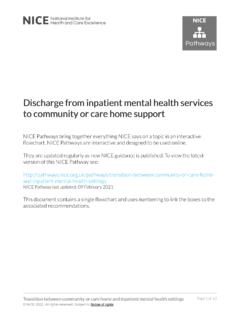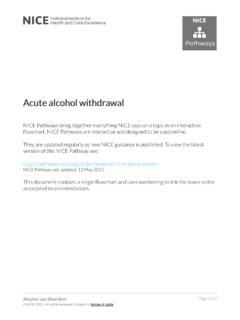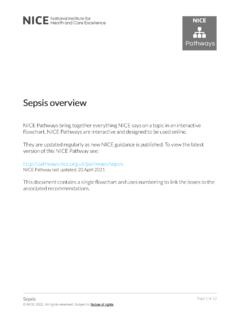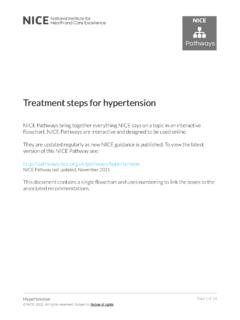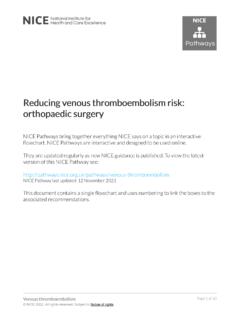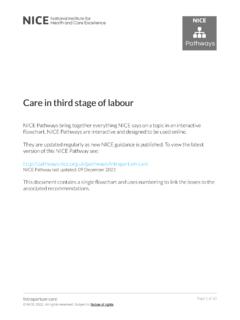Transcription of Antidepressant treatment in adults
1 Antidepressant treatment in adults NICE Pathways bring together everything NICE says on a topic in an interactive flowchart. NICE Pathways are interactive and designed to be used online. They are updated regularly as new NICE guidance is published. To view the latest version of this NICE Pathway see: NICE Pathway last updated: 05 October 2021. This document contains a single flowchart and uses numbering to link the boxes to the associated recommendations. Depression Page 1 of 14. NICE 2022. All rights reserved. Subject to Notice of rights. Antidepressant treatment in adults NICE Pathways Depression Page 2 of 14. NICE 2022. All rights reserved. Subject to Notice of rights. Antidepressant treatment in adults NICE Pathways 1 Person starting Antidepressant treatment No additional information 2 Choosing an Antidepressant For additional considerations on using antidepressants and other medications (including the assessment of the relative risks and benefits) for women who may become pregnant, please refer to the BNF and individual drug summary of product characteristics.
2 For women in the antenatal and postnatal periods, see also the NICE Pathway on pharmacological treatments for antenatal and postnatal mental health problems. Discuss choice of Antidepressant , covering: anticipated adverse events for example, side effects and discontinuation symptoms (see stopping or reducing antidepressants [See page 10]). potential interactions with concomitant medication or physical illness the person's perception of the efficacy and tolerability of any antidepressants they have previously taken. Normally choose an SSRI in generic form. Take the following into account: SSRIs are associated with an increased risk of bleeding. Consider prescribing a gastroprotective drug in older people who are taking NSAIDs or aspirin. Fluoxetine, fluvoxamine and paroxetine have a higher propensity for drug interactions. For people who also have a chronic physical health problem, consider using citalopram or sertraline as these have a lower propensity for interactions.
3 Paroxetine is associated with a higher incidence of discontinuation symptoms. Take into account toxicity in overdose for people at significant risk of suicide. Be aware that: compared with other equally effective antidepressants recommended in primary care, venlafaxine is associated with a greater risk of death from overdose the greatest risk in overdose is with TCAs, except for lofepramine. When prescribing drugs other than SSRIs, take into account: the increased likelihood of the person stopping treatment because of side effects, and the consequent need to increase the dose gradually, with venlafaxine, duloxetine and TCAs Depression Page 3 of 14. NICE 2022. All rights reserved. Subject to Notice of rights. Antidepressant treatment in adults NICE Pathways the specific cautions, contraindications and monitoring requirements for some drugs that non-reversible MAOIs, such as phenelzine, combined antidepressants and lithium augmentation of antidepressants should normally be prescribed only by specialist mental health professionals (for more information see sequencing treatments [See page 7]).
4 That dosulepin should not be prescribed. When prescribing antidepressants for older adults : prescribe at an age-appropriate dose taking into account physical health and concomitant medication monitor carefully for side effects. Agomelatine The appraisal of agomelatine for the treatment of major depressive episodes (NICE technology appraisal 231) was terminated because no evidence submission was received from the manufacturer or sponsor of the technology. Therefore NICE is unable to make a recommendation about the use in the NHS of agomelatine for the treatment of major depressive episodes. 3 Additional considerations for people with a chronic physical health problem When prescribing antidepressants, be aware of drug interactions and seek specialist advice if uncertain. If needed, refer the person to specialist mental health services for continued prescribing. Do not prescribe subtherapeutic doses of antidepressants. Take into account: additional physical health problems side effects of antidepressants that may impact on the underlying physical disease that there is currently no evidence to support using specific antidepressants for particular physical health problems.
5 Depression Page 4 of 14. NICE 2022. All rights reserved. Subject to Notice of rights. Antidepressant treatment in adults NICE Pathways Interactions of SSRIs with other medications Medication for chronic Recommended Antidepressant (s). physical health problem Do not normally offer SSRIs but if no suitable alternatives can be identified, offer gastroprotective medicines (for NSAIDs example, proton pump inhibitors) together with the SSRI. Consider mianserin, mirtazapine, moclobemide, reboxetine or trazodone Do not normally offer SSRIs Warfarin or heparin Consider mirtazapine (note that when taken with warfarin, the international normalised ratio [INR] may increase slightly). Use SSRIs with caution if no suitable alternatives can be identified, offer gastroprotective medicines together with the SSRI. Aspirin Consider trazodone, mianserin or reboxetine when aspirin is used as a single agent Consider mirtazapine 'Triptan' drugs for Do not offer SSRIs migraine Offer mirtazapine, trazodone, mianserin or reboxetine Monoamine oxidase B.
6 Inhibitors (for example, Do not normally offer SSRIs selegiline and rasagiline) Offer mirtazapine, trazodone, mianserin or reboxetine Theophylline, clozapine, Do not normally offer fluvoxamine methadone or tizamidine Offer sertraline or citalopram Flecainide or Offer sertraline as the preferred Antidepressant propafenone Mirtazapine and moclobemide may also be used Depression Page 5 of 14. NICE 2022. All rights reserved. Subject to Notice of rights. Antidepressant treatment in adults NICE Pathways Atomoxetine Do not offer fluoxetine or paroxetine Offer a different SSRI. 1. 4 Starting Antidepressant treatment : information, monitoring and initial lack of response Information Explore any concerns the person has about taking medication and provide information, including: the gradual development of the full Antidepressant effect the importance of taking medication as prescribed and the need to continue beyond remission potential side effects and drug interactions the risk and nature of discontinuation symptoms (particularly with drugs with a shorter half- life, such as paroxetine and venlafaxine).
7 The fact that addiction does not occur. Monitoring For people who are not considered to be at increased risk of suicide, normally see them after 2. weeks. See them regularly, for example every 2 to 4 weeks in the first 3 months, and then at longer intervals if response is good. For people who are considered to be at increased risk of suicide or are younger than 30 years, normally see them after 1 week and then frequently until the risk is no longer clinically important. If a person experiences side effects early in treatment , provide information and consider: monitoring symptoms closely if side effects are mild and acceptable to the person or stopping or changing to a different Antidepressant if the person prefers or short-term concomitant treatment (usually no longer than 2 weeks) with a benzodiazepine if anxiety, agitation and/or insomnia are problematic, except in people with chronic symptoms of anxiety; use with caution in people at risk of falls. 1.
8 Refer to appendix 1 of the BNF and appendix 16 of depression in adults with a chronic physical health problem Depression Page 6 of 14. NICE 2022. All rights reserved. Subject to Notice of rights. Antidepressant treatment in adults NICE Pathways People who start on low-dose TCAs and have a clear clinical response can be maintained on that dose with careful monitoring. Initial lack of response If improvement is not occurring on the first Antidepressant after 2 to 4 weeks, check that the drug has been taken as prescribed. If response is absent or minimal after 3 to 4 weeks of treatment with a therapeutic dose of an Antidepressant , increase support and consider: increasing the dose in line with the summary of product characteristics (SPC) if there are no significant side effects or switching to another Antidepressant if there are side effects or if the person prefers. If there is some improvement by 4 weeks, continue treatment for another 2 to 4 weeks. Consider switching antidepressants if: response is still not adequate or there are side effects or the person prefers to change drug.
9 Quality standards The following quality statements are relevant to this part of the interactive flowchart. Depression in adults 11. Reassessing people prescribed antidepressants 12. Lack of response to initial treatment within 6 to 8 weeks 5 Is there an adequate response to treatment ? No additional information 6 Sequencing treatments after an inadequate response Also see information on combining psychological and drug treatment . Depression Page 7 of 14. NICE 2022. All rights reserved. Subject to Notice of rights. Antidepressant treatment in adults NICE Pathways Switching and combining antidepressants When reviewing treatment after an inadequate response to initial pharmacological interventions: check adherence to, and side effects from, initial treatment increase the frequency of appointments be aware that using a single Antidepressant is usually associated with a lower side - effect burden consider reintroducing treatments that have been inadequately delivered or adhered to, including increasing the dose or switching antidepressants.
10 When switching antidepressants, consider: initially, a different SSRI or a better-tolerated newer-generation Antidepressant subsequently, an Antidepressant of a different class that may be less well tolerated (such as venlafaxine, a TCA or an MAOI). Do not switch to, or start, dosulepin. Normally switch within 1 week for drugs with a short half-life. Consider interactions and exercise caution when switching: from fluoxetine to other antidepressants from fluoxetine or paroxetine to a TCA; use a lower starting dose of the TCA (particularly when switching from fluoxetine). to a new serotonergic Antidepressant or MAOI (features include confusion, delirium, shivering, sweating, changes in blood pressure and myoclonus). from a non-reversible MAOI: a 2-week washout period is required (do not routinely prescribe other antidepressants during this period). Do not normally combine antidepressants in primary care without consulting a consultant psychiatrist. Also: select medications that are safe to use together be aware of the increased side - effect burden document and discuss the rationale with the person, inform them if off-label medication is offered, and monitor for adverse effects ensure familiarity with the primary evidence and consider obtaining a second opinion if the combination is unusual, the evidence for the efficacy of a chosen strategy is limited or the risk-benefit ratio is unclear.

